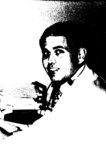Christopher K. Coleman's Blog, page 4
November 24, 2015
Paranormal Hopkinsville, Pt. 2: Case of the Kelly Green Men
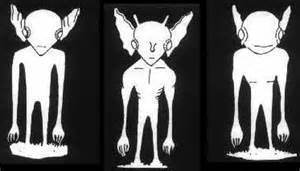
Sketches of the little green men the Sutton family saw
In addition to being the home of the Sleeping Prophet, Pennyrile’s Hopkinsville next biggest claim to fame is to being the location of the Great Goblin Encounter, also known as Kelly Green Men Case. We should note at the outset that the creatures described, while green were not Kelly Green; rather, Kelly was the rural community just outside of Hopkinsville where the close encounter occurred. Just about everything else about the incident has been disputed ever since.
The incident occurred in 1955 and to this day ranks as one of the best documented—and scariest—close encounters in UFOlogy. Seven persons from two farm families witnessed the events and their accounts, examined and cross-examined repeatedly over the years, have stood up to withering criticism and scorn and remained remarkably consistent.
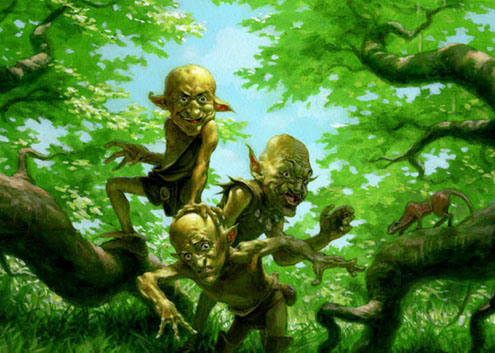
Duendes or green goblins, as rendered by artist from folklore, similar to the Kelly aliens.
On the evening of August 21, 1955, Billy Ray Taylor of Pennsylvania was visiting the Sutton family in the rural community of Kelly, in Christian County outside of Hopkinsville, Kentucky. As the house had no indoor plumbing, sournt 7pm Billy Ray went outside to the pump to get some water. It was at theis point that he observed strange multi-colored lights to the west, which he interpreted as a disc shaped craft of some sort. He ran into the house all excited and told the gathering he had seen a flying saucer. The assembled multitude scoffed at his sighting, reassuring him that he must have seen a shooting star or some such.
Then, about an hour later, the group began to hear eerie and unexplained sounds outside. The Sutton’s dog began barking wildly, as if there were strangers lurking about; then the dog suddenly became terrified and quickly ran under the house, where it remained for the duration. Billy Ray and the family patriarch, Elmer “Lucky” Sutton, grabbed some guns and went outside to investigate. There they saw a strange creature coming at them from a line of trees. When it got within about twenty feet, they let loose a volley, one of which was a twelve gauge and the other a 22 cal. varmint gun. The creature flipped over and then ran into the darkness; the boys were sure they’d hit it.
Stepping off the porch, they went in search of the creature, when they spied another one sitting on an awning. Again they fired and knocked it off the roof. But as before, although they were sure they had scored a direct hit, the being seemed unharmed. A bit shaken by the encounter, the duo went back into the house. Then, a few minutes later, Lucky’s brother, J. C. Sutton, saw another creature peering into the house through a window. J.C. and Solomon, another kin, fired through the window at them, seemingly to no effect. For the next several hours the little green men played whack a mole with the Taylors and Suttons, popping up at windows and doors, with the two families replying with hot lead. Whenever they scored a hit, they heard a hollow rattling sound, like banging around in a metal drum. The creatures also seemed to float off the ground at times, rather than walk. Finally, the family matriarch, Grandma Lankford, counseled the boys to stop shooting at the creatures; not only did it not seem to have any effect, but the creatures did not seem to mean any harm to the humans. Because the small children were badly frightened, around 11pm the group made a break from the house and got into their cars, making it to the Hopkinsville Police Department around 11:30pm, where they filed a report.
Police Chief Russell Greenwell, in filing his report, noted that the group were visibly shaken by the experience beyond reason. The Suttons, he noted, were not folks easily upset and not prone to filing complaints to the police; without weighing in on the accuracy of their account, he concluded that “something frightened them, something beyond their comprehension.” The witnesses were also judged not to be under the influence of alcohol or drugs at the time.
Elsewhere in Christian County, around 11pm a state trooper reported seeing “unusual meteor-like objects” flying overhead, with a sound “like artillery fire” emanating from them. The police officers visiting the Sutton farmstead themselves witnessed the strange lights in the sky and in the nearby woods (although later, some would refuse to talk openly about it). To their surprise, the officers found that nearby neighbors were also terrified and reported seeing the same strange lights in the sky, and strange sounds, at their homesteads and diners at the local Shady Oaks restaurant, also reported seeing the strange lights in the sky. .
The Hopkinsville police investigated the farmstead that night, found numerous bullet holes and hundreds of spent shells. They found a luminous patch of unknown substance on one of the fences were a creature had been shot but neglected to collect a same for testing. In the distance a green light was seen that night. When the police left around two am, the green men returned and kept poking around the farmhouse until close to dawn. They were never seen again.

Contemporary newspaper clipping of the Kelly Case.
In the days and weeks that followed, the incident garnered national publicity and scores of curiosity seekers came visiting, some in awe, many to scoff. People accused the witnesses of being drunk or of being liars and the usual professional debunkers fabricated their usual explanations to deny what had happened. While at firs the Suttons freely told the press and others of their experience, eventually the ridicule and criticism by self-anointed experts caused the family to refuse to discuss their encounter.

A 39 foot replica of the flying saucer built for the annual Kelly UFO festival near Hopkinsville, KY.
Apparently military types visited the farm to investigate the close encounter. The Air Force denies ever visiting the Sutton farmstead, but Project Blue Book listed the case as a hoax without comment. It is curious that Project Blue Book could make that judgment if, as they say, they never investigated it. It should be noted, however, that Hopkinsville is not far from Fort Campbell, Kentucky, which, while not an Air Force base, is home to the 101st Airborne Division and various Special Operations units; some are known, such as Delta Force, others remain top secret. What Special Ops units were operating there in 1955 is not known. In 1957, one Air Force spokesmen theorized that the creatures were just some circus monkeys, painted silver, who’d escaped–which was perhaps the least believable of all the vain attempts to rationalize away the event.
Because of the creatures green color, they began to be referred to as “Goblins” by some in the medai. Over time the cynics grew tired of their scoffing and the locals began to embrace the incident as part of their local lore. The 5th annual “Little Green Men” Days Festival was held at Hopkinsville in August, 2015. The artist’s impressions of these “Green Goblins” is even said to have inspired one of the many Pokeman anime characters.
While people celebrate the event in song and story, to Lucky Sutton and his family it was serious business and remained so for the rest of their lives. As his daughter related as an adult, “He never cracked a smile when he told the story because it happened to him and there wasn’t nothing funny about it. He got pale and you could see it in his eyes. He was scared to death.”

Strange tales of unexplained phenomena and paranormal activity in the Mid-South, including the Pennrile Region.
For more strange stories of unexplained lights, close encounters and unidentified flying weirdness in the Mid-South and elsewhere in Dixie, see: Strange Tales of the Dark and Bloody Ground and Dixie Spirits.
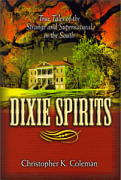
A compendium of strange, unexplained and uncanny events and places throughout the South.


November 22, 2015
Paranormal Hopkinsville Part 1: The Sleeping Prophet
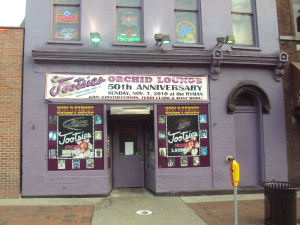
TOOTSIE’S ORCHID LOUNGE one of the oldest and greatest Honkey Tonks in Music City–and most haunted!
If one were to plan a paranormal sightseeing vacation of the mid and upper South, after leaving Nashville’s haunted Lower Broad honkey-tonks and Opryland’s occasional Lady in Black, the logical way to go would be northwards to Adams, Tennessee, the home of the Bell Witch. Some say the old girl still haunts the place, especially when the summer’s heat and humidity have gone away and the scent of smoke arising from tobacco curing barns wafts the air in the countryside.
When I first visited Adams, lo those many years ago, it was a quiet hamlet slowly falling into decay. When I enquired about the Bell Witch, the God fearing folk preferred not to discuss her. Whether this was because it was just stuff and nonsense, or more because they feared that talking about her would summon her spirit back, I cannot say. But luckily there were a few good ol’ boys who did not give a rat’s ass about the Mysterious Spirit who directed me to the Witch Cave attraction, nestled close on to the Red River. I have discussed the Bell Witch extensively in Strange Tales of the Dark and Bloody Ground and also a bit more about her and other Tennessee witches in Ghosts and Haunts of Tennessee, so I won’t chew my cud twice on that score—at least not here. But if you take Highway 41 up the road apiece beyond Adams, you will soon cross the Tuck-asee state line and come to Hopkinsville, Kentucky, a place equally worthy of note for those who derive joy in being scared out of their wits by paranormal phenomena and other high strangeness.

This image is the closest we have as to what the Bell Witch may have looked like. Here she is terrorizing the Bell children.
Hopkinsville, while considerably more urban in character than Adams, is still a quiet town most times and hardly a place one would peg as the epicenter of unexplained events or strangely gifted people. Yet on both counts Hopkinsville can hold its own with places more famous or more populous. For one thing, it is the home of Edgar Cayce, world renown as the “Sleeping Prophet.” Edgar Cayce was an unlikely candidate for notoriety, at least to start with. Born in 1877, in Beverly, just a stone’s throw south of Hopkinsville and his father would knock him about because he was such a poor student in school. When he was very young and wandering in the woods he claimed to see “little folk” cavorting about and occasionally spotted his dead grandfather. He knew grandpa was dead because he could see through him.
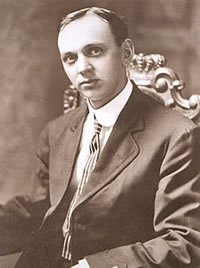
By 1910, when this photo was taken, Edgar Cayce had already become nationally famous for his readings.
At the age of ten he was taken to church and from that time on diligently began reading the Bible. Then, at the age of twelve one day an angel appeared to him in a woodland shack as he was doing his daily Bible reading. The angel told him his prayers would be answered and asked him what he wanted. Cayce allegedly replied that most of all he wanted to be helpful to others, especially sick children. On advice of this same mysterious “lady” he found that if he slept on a school textbook, he would absorb all its knowledge while he slept and he soon became an exceptional student. By 1892 Cayce was giving “readings” in his sleep relating to people’s health issues, although he tried to support himself with a number of day jobs. Although he never charged for a “reading” at one of his sleep sessions, eventually followers donated enough money to support Cayce that he could concentrate on his readings, which began to expand from health issues in to metaphysics and prophesy. He moved to Selma, Alabama from 1912 to 1925 and from then to his death in 1945 lived in Virginia Beach, but he was buried in his hometown of Hopkinsville. Edgar Cayce, unlike many mediums, was not dogmatic about his readings and advised people to accept them only to the extent they benefitted from them; likewise he always advised to test them against real world results. When awake, Cayce claimed no conscious memory of what he had said or why he said it. His utterings remain closely studied to this day and some say they have proven remarkably accurate.

New York Times article, dating to 1910, chronicling Edgar Cayce’s renown as a healer and psychic.
Hopkinsville is in the heart of the Pennyrile region of southern Kentucky—or Pennyroyal as some more refined folk prefer to call it—and there is available for traveler’s a “Edgar Cayce Cell Phone Tour” of Hopkinsville, while the Pennyroyal Area Museum has devoted a good part of its exhibition space to Cayce and artifacts relating to him. Hopkinsville, being part of Bell Witch Country, also celebrates the Old Girl in October every year. There is also the annual Edgar Cayce Hometown Seminar, usually held in March, which celebrates Cayce’s life and readings.

Ghosts and Haunts of Tennessee
For more about the Tennessee The Bell Witch and Pennyrile oddities, go to Strange Tales of the Dark and Bloody Ground.
Also see Ghosts and Haunts of Tennessee for more weird witchery as well.
For exhibitions on Edgar Cayce, go visit:
The Pennyroyal Area Museum 217 East 9th Street Hopkinsville, KY 42241 (270) 887-4270


October 30, 2015
TOOTSIE’S ORCHID LOUNGE: THE HAUNTED HONKEY TONK

TOOTSIE’S ORCHID LOUNGE one of the oldest and greatest Honkey Tonks in Music City–and most haunted!
Of all the many haunted buildings in downtown Nashville, surely one of the most haunted is Tootsie’s Orchid Lounge! At 422 Broadway, it’s smoke-stained walls and beer-stained floors have seen the greats of Country Music pass through its swangin doors–not to mention a few Rock stars as well.
Behind the bar, its back door opens onto an ally which faces the old stage door to the Ryman Auditorium. In the old days, when the Grand Ole Opy’s home was the Ryman, the now legendary stars of County would toddle across the alley to Tootsie’s to pull back a few brews in between sets. Sometimes when in their cups they would get up on the stage of Tootsie’s and play for free, and by all accounts, their performance on the stage of Tootsie’s was far better than what you would see on the straight-laced stage of the Opry. In those days they wouldn’t even allow drums or brass on stage to back up the performers. Sometimes, the old Country greats had one too many a drink and never made it back to the Opry for a second set.
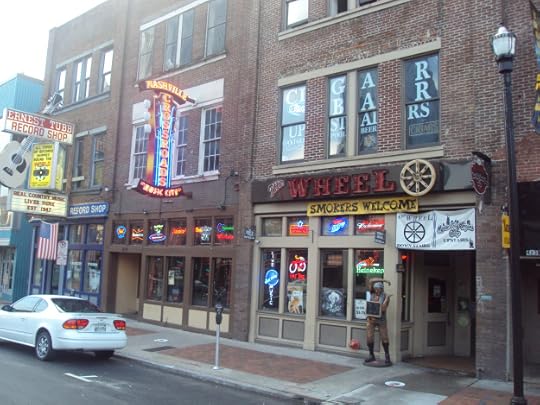
Almost all the Honkey Tonks of Music City’s Lower Broad have at least one ghost haunting is hallways.
The old owner of the bar, Tootsie herself, was a tough old broad, but with a heart of gold and she was known to give perspiring musicians a handout and a hand when they needed one. She is long gone and so are the old legends of Country—but not their ghosts.
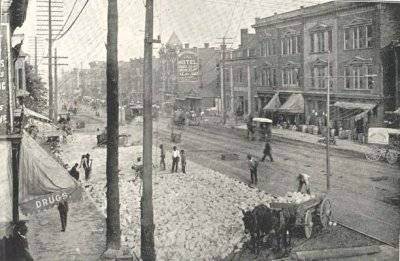
Lower Broadway in the old days. Many of the Honkey Tonk’s buildings date to before the Civil War and have many generations of ghosts haunting them.
In the hustle and bustle of the crowded bar you might never notice when the odd ghost or two is also listening in to the show. But sometimes a cold draft of air will fill the air and a door open or close on its own. Perhaps it is Hank Williams Sr. trying to make it back to the stage of the old Opry; or one of a dozen other spectral singers whose shades still dwell there: hard to say. The alley out back has also been witness to apparitions, seen passing back and for between the Ryman and Tootsies.
Upstairs, where Willie Nelson once camped out, thanks to Tootsie’s good graces, other ghosts have sometimes been reported as well. All told, living or dead, the spirit of Country Music is very much in evidence at Tootsies.
For more about the Haunted Honkey Tonks and other Music City ghosts, see: Ghosts and Haunts of Tennessee .
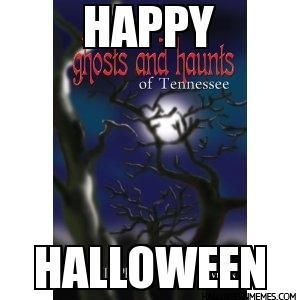
Happy Halloween!


October 22, 2015
Spectral Carnage at Carnton

Carnton Mansion, one of the more haunted Civil War sites in the South.
“Many thousand bodies here
Lay rotting in the sun:
But things like that, you know, must be
After a famous victory.”
Although recent transplants to Middle Tennessee are only dimly aware of it, the Cumberland Valley and its surrounds were much fought over during the Civil War. Although that is not the origin of the phrase, this section of the South amply earned its moniker The Dark and Bloody Ground during the Late Unpleasantness. Many an old house is home to a resident ghost or two who date back to the dark days of the war. The causes of their continued residence on the mortal plain may differ, but as often as not it is due to their violent or untimely death, being cut down in the prime of life, often with great pain and the awareness they will never to see their loved ones again. Sometimes that agony and anguish are all that remain.
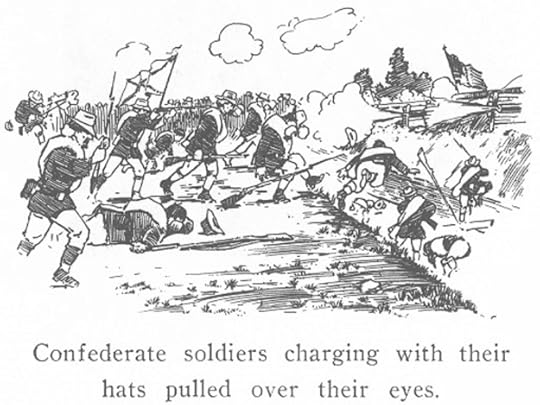
Confederate troops charging the Yankees at Franklin, by a veteran.
Such, it seems, is the case with Carnton Mansion, the grand home sitting on the southeastern outskirts of Franklin, Tennessee. The very name of the manse is suggestive of death, for in ancient Celtic tradition, a cairn or carn was a place where a warrior would be buried who had died with honor in battle. During the Civil War, late one Autumn day, the mansion would earn its name, a reputation that endures to the present day.
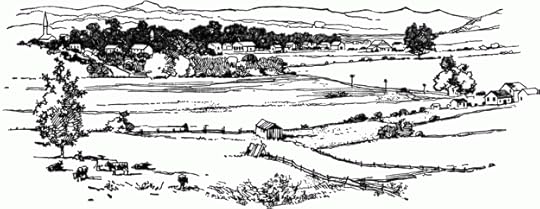
A sketch of the open fields the Rebels had to charge over–a longer distance than Pickett’s Charge. via Harpers
After the fall of Atlanta, Sherman planned his next move; ignoring the still viable Confederate Army of Tennessee, he would conduct a scorched earth campaign across Georgia, destroying everything in his path. Basically, it was an act of terrorism, designed to cow the white civilian population of the South into submission and break their will to resist. The Rebel army, now under General John Bell Hood, at first fenced with Sherman, attacking his rear and threatening his long supply line heading back northward towards Nashville. Then, when Sherman began marching south, Hood began marching north; a bold move not only to draw Sherman’s army after him but also to seize the mass of supplies stockpiled in the strategic city of Nashville; from there he could threaten many other places further north. It was a bold strategy and whatever historians may say about General Hood, he never lacked for either courage or boldness: “all lion” is how one postwar writer characterized him.
A small Union army was deployed to slow Hood as he marched northwards, to give time for the Yankees to gather more troops to defend Nashville. General John Schofield, a classmate of Hood’s from West Point days, was placed in charge of this Yankee force and basically his task was to hold the lion’s tail without being devoured. At Columbia, then Springhill and finally at Franklin, Schofield’s men conducted a fighting retreat. While most historians portray the Autumn Campaign as a done deal and that a Southern defeat was inevitable, in truth it was a very near thing. Had circumstances just been a little different at any point; had orders been obeyed, had the Yankees marched or fought just a little less heroicly; had one Yankee brigadier not disobeyed orders, or some Rebel pickets not been quite so fatigued—at any point just a feather-weight of difference in the chain of circumstance–and we would be celebrating John Bell Hood as a brilliant commander and victor. But that was not to be.

The rear porch of Carnton, where five generals were laid out after the battle. The “general” is sometimes seen on the upper porch.
Others have chronicled the Autumn Campaign in great length; we needn’t go into it here. Our concern is with the aftermath. On the afternoon and evening of November 30, 1864, the two armies clashed on the outskirts of Franklin, Tennessee. Both sides fought and bled and died with uncommon courage, and by the early hours of the following morning the blood-soaked fields of Franklin found the Confederates in possession of the terrain. It was a Pyrric victory, however, for Hood’s army was decimated in the process: five generals, twenty colonels and thousands dead or grievously wounded, incapable of combat—all to fight the Yankee rearguard.
Even before the battle was over, however, the wounded began to make their way to Carnton Mansion, on the eastern flank of the battlefield. All through the night and on into the next day, the wounded and dead were brought in a steady stream to the stately antebellum mansion. The owner of the home, Randall McGavock, had served in the Confederate army but accepted a parole to look after his family and was a non-combatant; of course that did not prevent him from opening his home to the wounded.
By the following day, the dead were being piled in Carnton’s yard like cordwood; the back porch held the bodies of no less than five generals, while the moans of the suffering could be heard everywhere. For the dead and dying at Carnton, the victory at Franklin did not seem so glorious.

Carnton Cemetery, where many of the Confederate dead were interred.
In time, the McGavock’s home was cleaned of the awful carnage and the blood—where it would go away. In one room that had served as the operating room for surgeons, try as they might, they could not wash or bleach the blood from the floorboards; the stains always came back and cannot be erased. They linger there to this day. There were other things that linger about Carnton as well; some of a spectral nature.
Inside the mansion, several spirits have been detected by successive occupants of the mansion and more recently by visitors as well. On the second floor, for example, a presence some called “the general” could be felt and occasionally seen. In the graveyard, even to this day, visitors sometimes spot a man in Confederate garb. Other spectres have been observed elsewhere in the mansion or on the surrounding grounds. Many are the eyewitness accounts that recount encounters with the ghosts of Carnton. Some of these apparitions are well known; others just passing shades, as anonymous as many of the graves on the grounds.
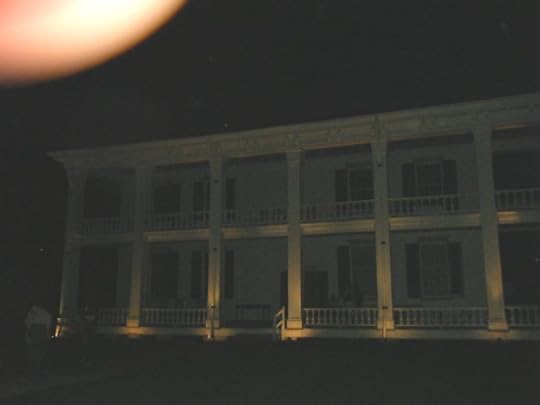
What seem to be a family of ghosts assembled on the back porch. The McGavock family?
Many speculate about the sightings reported at Carnton; a few doubt them, most do not. What is certain, however, is that for many of the men who fought and died at Franklin on November 30, the Battle of Franklin will never be over.
For more about the restless dead of Carnton and of Franklin Battlefield, see Strange Tales of the Dark and Bloody Ground and Ghosts and Haunts of the Civil War.
For a link to a YouTube video of the blood-stains that won’t go away, see this short piece by Kraig McNutt: https://www.youtube.com/watch?v=1fvVfiWOckQ#t=16
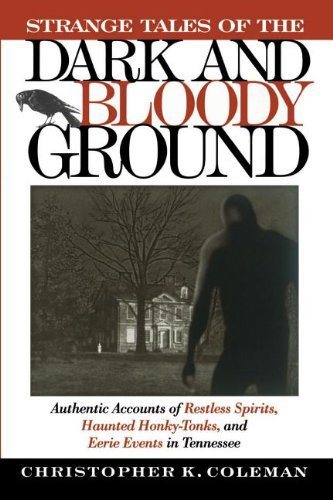
Strange Tales of the Dark and Bloody Ground chronicles several Battle of Franklin hauntings.


October 17, 2015
Wicked Witches of Appalachia
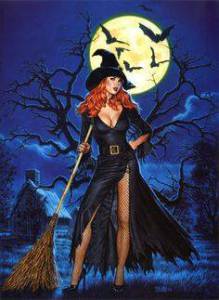
A modern take on the traditional witch has her bewitching readers in an entirely different manner
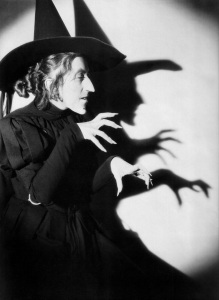
The late great Margaret Hamilton as the Wicked Witch of the West from an MGM publicity still ca.1939
Around Halloween time it is not to see images of alluring females bedecked in black and looking slinky and seductive in a witch’s costume. That is one modern stereotype; the other is of the ugly cock-eyed old crone with crooked nose and hairy mole leering out with a toothless smile. Yet another trope is those neo-pagans who enjoy getting nekkid, then dancing widdershins ‘round campfires and having mostly harmless devilry on selected nights of the year. The truth is that no of these stereotypes are true, at least not of real witches—and make no mistake real witches have existed and for aught I know still do—in the mountains of Tennessee. Of course I have gone into this in much greater depth in Strange Tales of the Dark and Bloody Ground, so for more about all this, you can learn about it there.

popular modern iconography of the witch and her familiars, the owl and the pussycat.
Of course the curious thing has always been that there were far many folk who would own up to being witch-hunters (also called ‘witch-doctors”) than those who would actually own up to being a genuine witch. And as I noted before, if they proudly proclaim themselves a witch, the likelihood is they are not. Still, it was not so long ago in East Tennessee that folks knew very well who in their community was and was not a witch. And for the most part they were not ugly nor sexy nor any kind of neo-pagan; but they were feared and avoided—and most, most wicked.
Before the creation of Smoky Mountain National Forest, the multi-county region it covered was home to several mountain communities, now no more. While the area back in the 1930’s was not quite so backward as Yankee journalists who never ever visited there might have proclaimed in their florid prose, but even by the backwards standards of the early twentieth century South, the folk up there were land rich, but dirt poor. Of course, if you raised your own crops and herds of livestock, there was always food on the table; but as far as modern luxuries went, such as indoor plumbing or electricity, well, that was something city folks enjoyed, not mountain folk.
Up around what is not national forest once lived a lady that was later known as “Witch McGaha.” It was not her Christian name, but then she was not the church going type anyhow. One thing that set folk wise to her was that she was continually trying to borrow things. It was not as though she needed anything; but if a witch can borrow three things from you, then sure as spit she can put you under her spell. Conversely, Witch McGaha would never, never lend anybody anything, not even to members of her own family. Many tales are told about her and her powers, but one will suffice for now
One time her sister, Nance, wanted some nice juicy apples from her sister’s orchard; but Witch McGaha would have none of it. Not one apple would she loan or give. Nance even got her mother to talk to her older sister to loan her some apples until her orchard came into its own, all to no avail. So Nance, too willful for her own good, snuck onto her sister’s orchard and started plucking them off the trees and putting them into a large tote sack. She bit into one and it was red, ripe and oh so juicy, just bursting with sweetness.

Vintage photo of members of a British tea party. Poison apples were served after tea.
When she had picked her full, Nance started off for home, thinking her sister would be none the wiser. Suddenly she felt a small tug on the helm of her dress; then another and another. A pack of bushy tailed grey squirrels had formed a ring around her and were giving her angry looks as the insistently tugged on her dress. She began to walk faster, but even more squirrels appeared. She broke into a run and dropped the sack but the growing horde of squirrels would not stop. Now they were scratching and biting and clawing at every part of Nance’s body and no matter how fast she ran they all held on and kept attacking her. By the time she reached the threshold of her house she was all bloody and her dress in shreds. Before she could cross the threshold and the safety of home, Nance McGaha keeled over, dead.
A common feature of Appalachian life was the local Wise Woman, a person who had knowledge of herbs but also knew how to conjur spells. In nineteenth century North Carolina, one such Wise Woman was especially famous, called “Mammy Wise” (actually her name was Weiss) and while not particularly wicked, she was a particularly talented Wise Woman. She claimed to have “spelt” the Civil War (she always regretted that); but she could also divine who a thief was in the community and was the first person to resort to when it came to cooking up a love potion. Mammy Wise was respected and honored on that side of the mountains, but no one with any sense ever tried to get on her bad side, for they knew what she could do.

Woodcut of a British witch ca. 1643. Any woman with herbal knowledge or healing skills could be accused of witchery. The real ones likely went unnoticed, practicing their craft in secret.
There were—are—other Wise Women in the high mountains, although these days they are far more discreet. Although society may be more tolerant these days of folk who claim to be witches, those with real power are wise enough to say little and mind their own business—especially when their business is the Dark Arts. For more about Appalachian Witches and their haunts, see Strange Tales of the Dark and Bloody Ground and Ghosts and Haunts of Tennessee.


October 8, 2015
A Franklin Homecoming: September 30, 1864
This Captain Carter is not the Rebel Soldier who ended up on Mars–but it turns out that he dwells in another Undiscovered Country.
 Originally posted on The Late Unpleasantness: A Civil War Blog:
Originally posted on The Late Unpleasantness: A Civil War Blog:
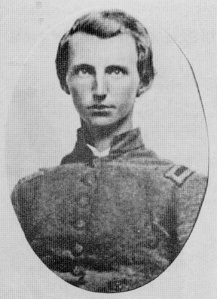 During the autumn of 1864, Captain Tod Carter was coming home to Franklin. He was coming home to stay.
During the autumn of 1864, Captain Tod Carter was coming home to Franklin. He was coming home to stay.
Although Thanksgiving as we know it originated with Abraham Lincoln’s proclamation of 1863, late November had long been the season of Harvest Home, of family and friends returning to gather around the hearth. November 30 was a homecoming of sorts; long distant fathers, brothers and sons were returning to Franklin; but it was not to visit loved ones and enjoy a bountiful meal and celebrate a successful harvest; it was to engage in a deadly and ultimately fruitless duel with their mortal foes. It would indeed end with loved ones seeing their returning family members–lying dead on the battlefield or slowing dying of their wounds.
 Fountain Branch Carter, the family patriarch, was still alive in 1864 to see the war come to his door.
Fountain Branch Carter, the family patriarch, was still alive in 1864 to see the war come to his door.
The first Yankee troops started filing past the Carter family home…
View original 673 more words


August 15, 2015
Our First Southern President and the Paranormal
Part 1: Washington’s Prophecy
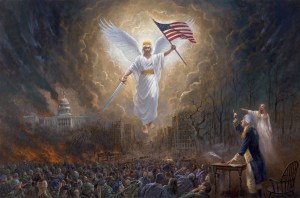
“I had seen a vision wherein had been shown to me the birth, progress, and destiny of the United States.” George Washington
Let’s see: we have looked at Thomas Jefferson and UFO’s and Abraham Lincoln and just about all things paranormal; let’s look at another Southern president’s supernatural encounters: George Washington. Since there is quite a bit out there about George and the uncanny, this promises to be a two part-er, at least.
Today we’ll look at the Washington Prophecy, which is as important as it has been underreported. This obscure incident from the American Revolution uncannily fore-shadows, not only the American Civil War, but possibly both world wars as well. For now for more about Washington and the Civil War, see Chapter 16 of Ghosts & Haunts of the Civil War.
Let us go back, then, to the winter of 1777, the “year of the three sevens” and the time when the American Revolution almost collapsed. It was a starving time for Washington’s army at Valley Forge: the troops were ill fed, ill clothed and freezing in their hovels. The Continental Congress, as Congress does today, did nothing to help. The well fed politicians were little concerned with those who were fighting and dying at the front; they were very concerned about protecting they and their rich patron’s wealth and privilege and not the Republic. The troops were starving, barefoot, were not being paid and on the verge of mutiny. Washington begged and pleaded for blankets, clothing and food, all to no avail; he was in fact on the verge of resigning as commander of the army. Against this background occurred an uncanny incident which has long been rumored about, but which we have a lone witness to its truth.

During the winter of 1777, General Washington had good cause to pray. It may be that the prophecy was in answer to these prayers
Our sole source for this incident was a soldier named Anthony Sherman. His account was first published in the 1840’s, in an obscure journal now unobtainable at any price. Fortunately, his account was reprinted after the Civil War in the National Tribune, a newspaper published for the benefit of Union veterans, mainly to enable them to get pensions from the Federal Government. As with the VA today, veterans and widows were often frustrated dealing with the government that they had defended, fought, and died or were disabled protecting. His account, having been told well before the Civil War, gains additional credibility thereby.
Sherman (no relation to the general) was an ordinary soldier, posted to Washington’s headquarters at Valley Forge at the time. One day, General Washington emerged from his private quarters, where he had been alone for some time. Emerging visibly shaken, he began to relate what he had experienced to a trusted aide (Sherman does not say whom, but it was likely Alexander Hamilton). Sherman was close enough to the two to hear what Washington said, and what the general had to say remained seared into Sherman’s memory.
Washington, alone at the time, was in his office praying. Now in normal times Washington was not an overly religious. Washington was a product of the enlightenment, when most educated gentlemen regarded God (if they regarded him at all) as a sort of divine “clock-maker” who wound up the universe and then stood back and watched it move on its own. However, the winter of 1777-78 was “the time that tries men’s souls” and that winter Washington if fact prayed quite a bit for divine guidance.
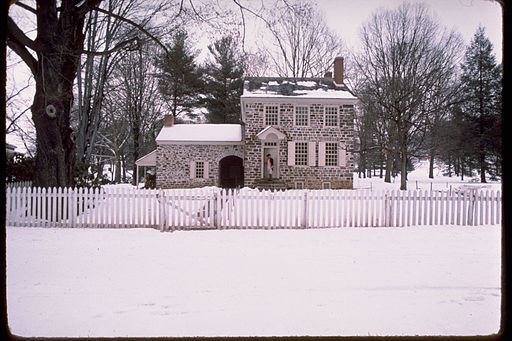
Washington’s Headquarters, Valley Forge, where he is believed to have had a prophetic vision.
Washington was in his office, alone, when he became aware of a presence in the room. He said it was “a singularly beautiful being,” with whom the general tried to communicate. After he addressed the figure several times, she finally responded. The room’s walls seemed to disappear and his surroundings became luminous.
‘Son of the Republic, look and learn,’ she said to Washington, and then spread out her hand in a sweeping gesture several times. Each time an angelic being dipped water from the ocean and cast it over the continents of Europe, America, Asia and Africa. On the third such cast “from Africa I saw an ill-omened specter approach our land,” Sherman heard Washington say. The imagery as reported later was complex; visions of war and destruction, the blasting of trumpets and other scenes which seemed to presage war and ultimate victory. Clearly, at least part of this version related to the Civil War.
Not surprisingly, ever since this account was first published, there have been professional debunkers ever eager to disprove its veracity. One industrious researcher located the records of a young officer of the Revolution and triumphantly announced the story a fake, because the Anthony Sherman in question had been at Saratoga and not at Valley Forge. Of course, debunkers always go for pat answers and the fact that there very well may have been more than one soldier named Sherman in service during the American Revolution never entered his closed mind. Any researcher or genealogist dealing with old records is aware how fragmentary such records often are: muster lists and service records get lost, court house archives burn up in fires and the like. But the professional debunkers prefer to ignore such realities in their quest to prove their a priori assumptions.
When dealing with prophecy, of course, we are always dealing with a two edged sword. Prophecies are generally committed to paper years after the events have come true, they often have cryptic symbolism and when based on only one reporter’s account it is easy enough to discount. In this case, while another version of the prophecy seems to have been previously published well before the war, that original publication, like many early American periodicals, has not survived. The earliest extant publication is by an erstwhile Philadelphia journalist and dates to the eve of the Civil War, when many such prophecies about the onset of war were in the air.
Even so, the account as published on the eve of war related to far more than just the onset of the Civil War. For one thing, “the singularly beautiful being” also says to Washington, ‘Son of the Republic, the end of the century cometh; look and learn.’ If this were just propaganda meant for the northern public on the eve of Civil War, why would it refer to future generations?
Moreover, the beatific being also interprets the visions he has seen thusly: ‘Son of the Republic, what you have seen is thus interpreted. Three great perils will come upon the Republic. The most fearful is the third, but in this greatest conflict the whole world united shall not prevail against her.’
While the first conflict she mentions is easily dismissed as the Civil War, the second and third are not. While one can put whatever spin on them one wants, it takes no Nostradamus to interpret the second and third “perils” as the two world wars, and the third conflict in particular as World War II, which was indeed the “greatest conflict” and where indeed for a time it seemed the Axis Powers would take over the “whole world.” The professional debunkers of this prophecy conveniently leave out these parts of the prophecy, which clearly do not fit their smug theories and which, if they do not “prove” it, certainly give the prophecy much greater credibility to the modern reader.
As to who or what the “singularly beautiful being” may have been, several theories have been put forward. Some say the apparition was an angel; others say it was the Virgin Mary, who has been known to appear and deliver prophecies in that manner; more recently, the show Ancient Aliens theorized that she was an Alien (of course). However, the 1859 version makes no such assertions, so the reader is left to add their own speculations to the others.
Of course, as with any prophecy, one is free to believe or disbelieve, or to interpret it as one wishes. However, prophecies, it should be remembered, are not inevitable–they are warnings. While one can always ignore a warning, it is generally not wise to do so.
For more uncanny tales of the Dixie and the Civil War, go to: Dixie Spirits and Ghosts and Haunts of the Civil War. The “Angel of Liberty” painting is by artist Jon McNaughton and was also inspired by the Washington Prophecy. I claim no copyright for it and you can obtain prints of it directly from the artist: Jon McNaughton Fine Art .


July 29, 2015
Thomas Jefferson and the UFO
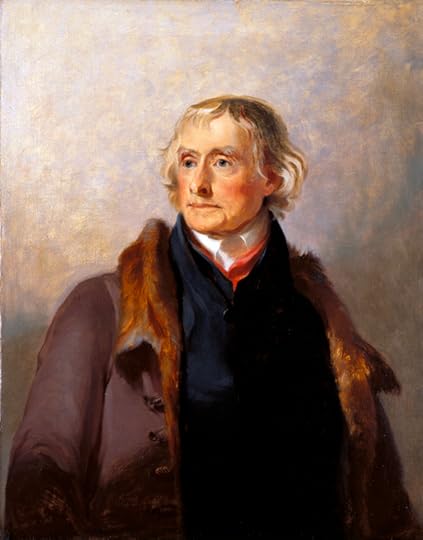
Thomas Jefferson, president of the United States, author of the Declaration of Independence and early ufologist.
While I normally write on paranormal topics rather than on UFO’s, where they involve a Dixie mystery, I sometimes make a detour to investigate various unexplained aerial phenomena. For example, in Strange Tales I researched the time one or more UFO’s buzzed the Tennessee Valley at the beginning of the twentieth century (multiple reports of that) and also rare Fortean falls of blood and gore in Tennessee and Kentucky. In Dixie Spirits I reported on a close encounter in West Virginia that Joe Nichol and his professional cynics have tried to explain away with a unique combination of arrogance and ignorance. Moreover, down in Pascagoula, Mississippi, I have written about the “singing river” mystery, of which I reported only a fraction of the weirdness known from that area; while I didn’t bring in any theories about alien beings being responsible, others have, citing numerous UFO, USO and close encounters in the area; what the truth behind all that phenomena around Pascagoula may be is still unresolved, but definitely something is, or has been, going on there that defies ordinary scientific explanation.
While there is a certain overlap between paranormal phenomena, cryptozoology and UFO’s, as a rule these are discrete and separate fields of inquiry. For one thing, most scientists do not take paranormal or supernatural accounts seriously and tend to dismiss them all, either as hoaxes or “delusions of the masses” when they can’t rationalize them away; whereas most scientists take the possibility of extraterrestrial life quite seriously, even if they might not accept the evidence of UFO investigators. The SETI program is quite well funded and other scientific programs have also been searching the skies for proof of life elsewhere in the universe—even on mars.
So when I learned of Thomas Jefferson’s own interest in unsolved celestial phenomena, it piqued my interest. Jefferson was very much a man of the enlightenment and he kept an open mind to many mysteries that lacked easy answers. He was one of the first, for example, to recognize that mammoths and mastodons roamed America and it is not generally appreciated that one of the goals of the Lewis and Clarke expedition was to go “looking for the elephant” and see if any still lived in the unexplored western territories at that time.
So we should not be surprised when, in 1800, Jefferson learned of a strange aerial sighting, he was moved to publish a report of it in a scholarly journal. We are beholden to Thomas J. for an accurate account of one sighting in Louisiana. Jefferson’s original correspondent was a gentleman planter named William Dunbar, a Scotsman by birth and a naturalist, astronomer, ethnologist and explorer living in Natchez, Mississippi at the time. In searching the Jefferson Papers, it turns out that one part of Dunbar’s missive to Jefferson survived, on Indian sign language, but not apparently his separate enclosure on the UFO, so we just have Jefferson’s summary of it. Like Jefferson, however, I will attempt to give an objective account of the sighting without too much speculation.
On night of April 5, 1800, an object was seen pass over Baton Rouge. It came from the southwest, flying low overhead and moved at an extremely high rate of speed, disappearing out of sight within a quarter of a minute. Eyewitnesses described it as being “as big as a house” and 70-80 feet long and being only some 200 feet above their heads when it passed.
It was described as being “wholly luminous but not emitting sparks” and Jefferson gives a vivid description of its luminosity: “of a colour resembling the sun near the horizon in a cold frosty evening, which may be called a crimson red.” When it passed overhead a considerable degree of heat was felt “but no electrical sensation,” by which I take Jefferson to mean that it was not ball lightening or similar phenomena. Immediately after it passed to the northeast a violent rushing noise was heard, indicating it was passing faster than the speed of sound; apparently the force of its passage bent trees before it and a few seconds later a loud crash was heard, “similar to that of the largest piece of ordinance” and a shock, like an earthquake, was felt as well.
Observers rushed to where the object landed and while the area plant life was burnt to a crisp and the ground much torn up, apparently there was no object found and Jefferson’s description does not indicate an impact crater either. What was it? Well, the simple answer would be a meteor of some sort. But if so, why was no debris from it found. Curious onlookers swarmed the area apparently, but no follow up report of finding a meteorite or fragments thereof were found. It was obviously very large and low flying, so one would expect a considerable zone of destruction if it had exploded above the ground, along the lines of the Tunguska explosion in 1909. Yet apparently that was not the case, since the nearby witnesses lived to tell the tale. Another curious fact emerges from Jefferson’s report; it sounds as if it were flying almost parallel to the ground; surely most meteors or other space debris would be falling at an acute angle, if not a near vertical angle.
I myself have seen a bright object come down a few years back. To the best of my knowledge no one else saw or reported it and it made no sound; like Jefferson’s UFO it disappeared within a few seconds. But it descended at a forty-five degree angle and while luminous it was not close to the ground. It may have been a small, bright meteorite, for if it been the size of Jefferson’s object it would have been noticed when it impacted. Of course, we cannot be certain that Jefferson’s object did indeed crash; it may have exploded mid-air and disintegrated into nothingness. Then too, it may have pulled up at the last moment and climbed up out of its gradual but supersonic descent; but if the latter, it would have to have been a manned craft and not simply some inert rock or fragment of a comet. This may have been the first such sighting, but apparently it was not the last. Checking recent accounts, there are evidently quite a few sightings of strange lights and aerial phenomena in the Baton Rouge area, pretty much ongoing, some of which have been recorded by camera or cellphone.
In an article on the University of Chicago website, Penelope, the blogger makes a similar point to mine, only does some interesting calculations:
Distance from impact:
6 km
Projectile diameter:
75 feet
Projectile density:
porous stone: 1500 kg/m3
maybe a bit more if some kind of craft, i.e., a semi-hollow metal object
Impact velocity:
0.6 km/s
Impact angle:
1.9°
Target type:
Sedimentary rock
The U. of C. blogger notes that: “if it was a house-sized object coming in at a meteoric speed, it would have been a huge event, with no survivors for miles, flattened trees, etc.” They point out that the object which created Arizona’s Meteor Crater would have been about 50 meters in size, or only about twice the size of the object reported by Dunbar. So, where’s the beef, as it were?
In the end, Jefferson’s report of a UFO leaves more questions than answers. What was it? Did it somehow recover from its rapid descent and peel off, leaving only burnt vegetation and blasted ground behind? Well, the honest answer is we simply don’t know and unless more information surfaces, we must continue to categorize it as an unidentified flying object.
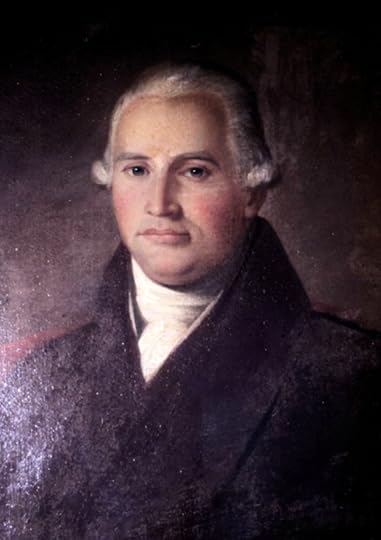
William Dunbar, naturalist, astronomer and explorer, was descended from titled nobility, but settled in Natchez and corresponded with Jefferson and other leading intellectuals of his day.
Sources:
Thomas Jefferson, Transactions, American Philosophical Society, vol. 6 Part 1 (Philadelphia, 1804), p. 25. Jefferson mentions an illustration, but none of the sources I consulted had it.
The Penelope website at the University of Chicago: http://penelope.uchicago.edu/Thayer/E/Journals/TAPS/6/Baton_Rouge_Phenomenon*.html
National Archives, Founders online: http://founders.archives.gov/documents/Jefferson/01-32-02-0037
For more unexplained phenomena, see Strange Tales of the Dark and Bloody Ground and Dixie Spirits.


April 29, 2015
Abraham Lincoln and Ancient Aliens
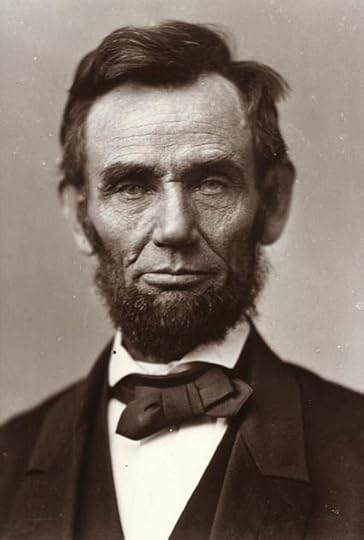
President Lincoln was one of the many prominent men of his day who attended s��ances; he also believed in prophecy and other psychic phenomena
I normally don���t write about UFO���s and Alien sightings, restricting my researches to paranormal phenomena, but I have delved into the subject on occasion as it relates to the South. In Strange Tales of the Dark and Bloody Ground, for example, I investigated the UFO sightings over the Tennessee Valley in the early 1900���s and a ���dark day��� in Memphis, while in Dixie Spirits I also chronicled a very credible close encounter in West Virginia. Then there are those strange events which may not be supernatural but which certainly defy all attempts at rational explanation, such as rains of blood and gore, aerial showers of snakes and other land going animals, as well as the Mothman enigma, which itself seems to transcend traditional categories. So while I have an abiding interest in UFO���s and the possibility of Aliens visiting our planet, I generally have left those investigations to those with the resources to properly probe them.
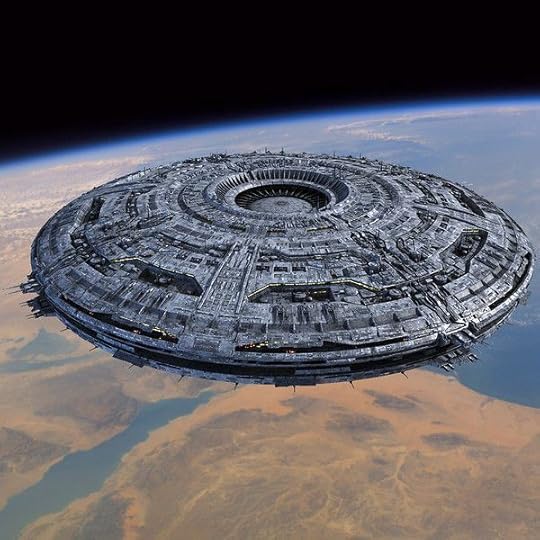
Artist’s conception of a mothership. Did one such ship hover over Memphis, Tennessee in 1904? See Chapter 37 of Strange Tales of the Dark & Bloody Ground.
That is why, when I was contacted by the folks at��the Ancient Aliens series on The History Channel to come on their show and discuss my researches on Abraham Lincoln and the paranormal as published in The Paranormal Presidency, I was a bit bewildered how I might fit into their show���s format. Nevertheless, last summer I did an interview with the folks at Ancient Aliens and discussed quite a bit about Lincoln���s beliefs in the paranormal and allied subjects, as well as also discussing Ambrose Bierce, whose Civil War career I have researched extensively, the results of which should be published later this year or early next. Bierce, although known as a cynic, in fact was fascinated by the bizarre, the unexplained and the unusual���in other words, a man after my own heart. As honored as I was to be on their show, however, I wondered how my own expertise would fit into their show���s concept. Well, the wait is over; earlier this month the History Channel aired an episode entitled ���Aliens and the Civil War.���
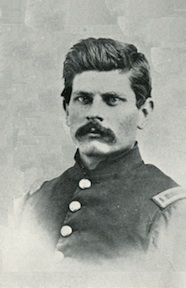
Ambrose Bierce as he looked during the Civil War. Was his war wound a source of his interests in the bizarre and unexplained? The Ancient Aliens show thinks so.
First off, I must say they did an excellent job of dovetailing what I had to say about Lincoln with other material relating to Alien contact and the Civil War. As is usual for this show, much of what they have to say is highly speculative; nevertheless, I thought much of what they argued was interesting, making connections between events and phenomena which I had not previously thought related to one another. Besides the Lincoln segment that I was on, they also discussed some other unusual phenomena which I have previously written about in Ghosts and Haunts of the Civil War, although my take on the incidents was different. There was, for example, the vision of Washington at Valley Forge and his later appearance at the Battle of Gettysburg, which I discussed in the Chapter ���Behold a Pale Rider������although their account of Washington���s visitation at Gettysburg differs from my research.
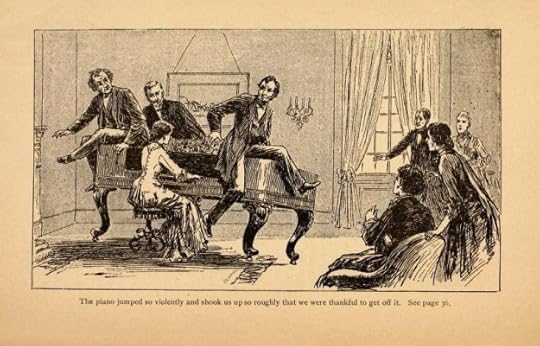
While attending one seance Lincoln was given a “ride” on a piano by, a “physical” medium.
The part of The Paranormal Presidency which they chose to excerpt from my longer interview revolved about Lincoln���s involvement with Spiritualism, in particular with a young psychic named Nettie Colburn���better known under her married name, Nettie Colburn Maynard. Although mainstream historians frequently label Nettie as a ���charlatan,��� my researches in the archives and other primary sources proved otherwise; likewise, some of the claims of other spiritualists about Lincoln���s involvement have been verified, at least in part. How deeply Lincoln was involved in the movement, however, remains subject to debate, but there is no question that he did attend s��ances and visit psychics, with and without his wife. That the ���spirits��� that contacted Lincoln���s psychics and advised the President could possibly be Alien life forms is something I had never thought of, but Ancient Aliens makes a case for these and other psychic encounters being due to the remote telepathic actions of extraterrestrials. Likewise, their tying Ambrose Bierce���s traumatic head would into a possible cause of his being psychically informed by Aliens may seem a stretch, but not totally dissimilar to Lincoln���s own near death experience being the possible cause of his own belief in premonitions and similar paranormal experiences.

Were Aliens in contact with Lincoln through the medium Nettie Colburn? (artist’ s conception of an alien somewhat upset with the Bad Hair Guy).
Bear in mind, the Ancient Aliens theories remain highly speculative, but some of the ideas they put forth in the episode ���Aliens and the Civil War��� are highly original and in some cases I think worthy of further investigation. Traditionally, UFO���s and the belief in Ghosts and the paranormal have been regarded as mutually exclusive. For one thing, most scientists accept the premise that intelligent life exists elsewhere in the universe; most of them have yet to accept the premise that earth has been visited by them.
In contrast, scientists as a group reject the supernatural or anything that resembles it and most reject any aspect of the paranormal as ���delusions of the masses.��� However, as theoretical physicists delve deeper into such things as Quantum Mechanics, and posit parallel worlds, alternate realities and similar seemingly incredible scientific theories, some scientists are no longer smugly scoffing at different types of paranormal phenomena, such as remote sensing, precognition, telekinesis and other things hitherto rejected as impossible. The possibility is growing that psychic communication at a distance, or foretelling the future may eventually be found to have a basis in reality, no matter how fantastic they may seem today.
All this reminds me of something that William Herndon, Abraham Lincoln���s law partner, once said about Lincoln���s unorthodox beliefs. He said that Lincoln did not so much believe in the supernatural as in the supra-natural; that what we may regard as defying the laws of nature may just be a part of the natural world which we cannot yet comprehend. Have aliens been in contact with us, by psychic or other means? Who is to say; what today may seem fantastic, may yet prove true.
“Aliens and the Civil War” aired on April 10, 2015��but you can see it on the Ancient Aliens Website: http://www.history.com/shows/ancient-aliens/videos/aliens-and-the-civil-war
My��latest book, Ambrose Bierce and the Period of Honorable Strife is due for release by The University of Tennessee Press later this year or early next.�� Look for it at better bookstores everywhere.


April 20, 2015
SOME COME BACK: A Primer on the Undead
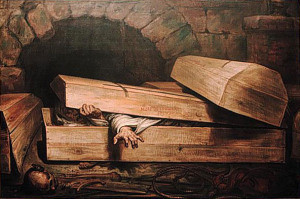
Some Come Back: on The Undead and the Walking Dead.
While I write true accounts of supernatural places and things, I am as fond as the next person of a good horror story, not to mention credible science fiction or well executed fantasy (the latter category, I’m afraid, is rarely well executed though). However, as I am hip deep in true accounts of the paranormal—or at least what I believe to be true—I get miffed at the widening gap between supernatural fictional and the real thing. Fiction writers are certainly entitled to use literary license in crafting their tales to entertain us and after awhile, I understand it gets difficult to come up with something new and original in the horror genre; but I also think tales of the supernatural should have some relationship to reality, however remote.
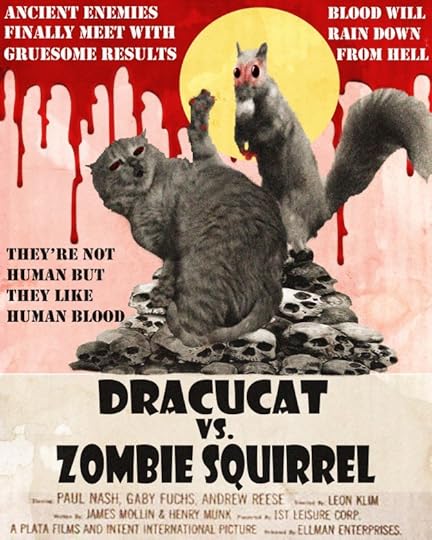
How far will Hollyweird take the Undead craze? As long as you buy it they’ll churn it out.
So today, boys and girls of all ages (as they used to say), we are going to provide a bit of a reality check—or surreality check—and correct some misconceptions which have arise about the undead, or at least in folk beliefs about them, versus the ever growing pop myths that seem to have snowballed out of control in recent years. I don’t expect to change any minds in Hollywood, much less in the ComiCon universe, but I least I can provide a bit of fresh air here and there to the stale stereotypes that have become dogma in pop horror.
First off, as a disclaimer, let me say that I do not go around abandoned buildings with a flashlight and camera aimed at my face trying to spook myself out; I do not claim to be psychic, although I have once or twice in my life had uncanny experiences which might qualify—as most people have—nor have I personally ever seen a fully embodied ghost. However, I have met many people, from all walks of life, whom I believe have genuinely experienced some kind of paranormal event. I do not have much truck with professional psychics, but I have on rare occasions met or known people who may well have genuine psychic abilities. While there are a lot of fakers around, and even more self-delusional believers, unlike the professional debunkers, I am willing to genuinely keep an open mind about the many phenomena which science is unable to adequately explain. And there is a lot out there which science can’t explain.
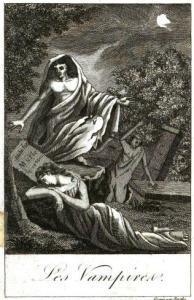
The association of sex with vampires is nothing new and goes back at least to the Victorian era.
So it is with accounts of the undead, a generic term for the belief that dead bodies may sometimes, somehow, reanimate. There are accounts I have come across which are credible enough for me to be willing to consider the possibility, even if hard evidence may be lacking, or if most of it is more folklore than fact. Can such things be? I don’t know for certain; of all paranormal phenomena it is the most elusive and even credible cases are few and far between. Yet western society, not to mention other world cultures, has a deeply engrained believed that such a thing is possible. One only to look to the New Testament and the story of Lazarus, as an example that the claim of bringing the dead back to life has been made. If you believe in the Bible, then you cannot reject the notion out of hand. Outside of Christianity, of course, there were people who were called necromancers—a type of sorcerer who specifically claimed to be able to reanimate dead corpses—although not necessarily with the soul still in it. So this whole thing is not a recent invention of some Hollywood hack; it has a background, a tradition, even if the hack writers have much abused it lately.
Modern pop horror is silly with stories of both zombies and vampires, both of which have a solid grounding in western beliefs, and it is these two types of undead which we are focusing on presently and which I propose to vent my peeves upon.

Bela Lugosi was for many years the stereotypical vampire; today’s bloodsuckers are younger and sexier.
First off, let us deal with the notion that vampires can be good or romantic, or somehow friendly or misunderstood. There are whole rows of paperbacks in bookstores dedicated to vampire romances these days, even broken down into equally popular sub-genres, such as teenage vampire romances. If there are such things as vampires that roam the night, let us understand what they really are: they are dead bodies, lifeless corpses, which have been reanimated by a demonic spirit. Nothing more, nothing less: so any notion that they are somehow misunderstood or lost, or in need of your company, is utter nonsense.
The belief that a malevolent spirit can somehow occupy a dead corpse originated in Eastern Europe in the Dark Ages and goes back to the split between the Eastern Church and the Western one. In Christianity one of the seven sacraments is Extreme Unction or Last Rights and while it can be administered to almost anyone who feels in need of spiritual healing, it has traditionally been administered to the dying. The trouble came in when they tried to determine how late one could administer the sacrament to a dying person; in other words, when does the soul leave the body? In the Western Church, they used the rule of up to one hour after clinical death; however, the Eastern Orthodox Churches were quite a bit more generous as to how long the soul might reside in the dead body and allowed up to thirty days to administer the sacrament.
But in those thirty days, especially in a colder climate, the dead flesh may still be viable and without visible signs of decay. What if the soul leaves the corpse; don’t you then have an empty vessel, suitable to be occupied by something else? Enter the vampire: an empty vessel reoccupied, not by the soul of the deceased, but by a demonic entity which has the power to reanimate the corpse and imitate the living. It is in the nature of demons to roam the earth seeking the ruin of souls; what better way to do so than to take the shape of a deceased and pass among human society with its true nature undetected? The business about sucking blood was a later addition: it is the life force which a demon seeks to drain and blood, itself a mysterious substance, is but the symbol of that life force. Novelist D. H. Lawrence wrote about “emotional vampires:” these are flesh and blood humans, not dead corpses, who gain strength and vitality by draining others of their emotional sense of well being. Doubtless we have all encountered an “emotional vampire” at one time or another and just not realized it: a co-worker or a relative who seems to leave all those around them drained of energy or strength. This is not supernatural, but I’m afraid is all too common.
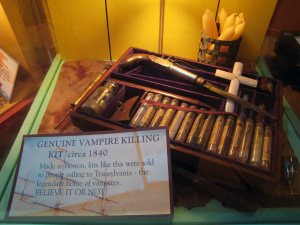
A genuine vampire hunting kit from the 1840’s.
Many years ago I read an account by the famed archaeologist A. J. B. Wace, the noted excavator of the city of Mycenae, famous from Homeric legend. He was engaged on a survey once in a less explored part of Greece, seeking out Late Bronze Age tombs. Most of the tombs had long ago been robbed of their contents, nut he came across one where the skeleton was still intact, with a bronze arrowhead still lodged in the chest where the heart would have been. With nothing else of value left in the tomb, Professor Wace took the arrowhead and also removed the skull from the skeleton for anthropological analysis. He thought nothing of the days work, until that night, and on succeeding nights, his camp was disturbed by an invisible intruder, apparently intent on vandalizing the camp. Professor Wace and his British team could make no sense of it as they had found nothing of value worth stealing; but the local Greeks workers claimed to know what was afoot: the excavators had taken the skull of a vrykolakas—the Greek version of the vampire.
People who have led a sinful life, who have been excommunicated or been buried in unconsacrated ground; all these are potential causes for a corpse to reanimate and become a vrykolakas. The activities of the vrykolakas are almost always harmful, although they may seem tame compared to the Hollywood version: it varies from merely leaving their grave and “roaming about” at night, to engaging in poltergeist-like activity, up to causing epidemics in the community. One local villager even claimed to have seen a headless skelton walking along the dirt track that led from the tholos tomb where had Wace gotten the skull and arrow towards their camp. The disturbances in camp nightly became more violent and were threatening to disrupt the expedition; so even though the British team had seen nothing themselves, they discretely put the skull back in the tomb and replaced the arrowhead in the ribcage of the skeleton. Once done, the disturbances ceased as suddenly as they had begun and for years afterwards the Greek villagers referred to the incident as “St. George the Vampire.”
In Strange Tales of the Dark and Bloody Ground, I relate the case of the discovery of a corpse in East Tennessee where the body was almost perfectly preserved but had a wooden stake through its heart—the traditional method of disposing of a vampire. I was at a loss to explain it, since vampires are traditionally an Eastern European or Near Eastern phenomenon and Anne Rice’s novels notwithstanding, not generally present in the South. However, after the book was published, I came across a reporter for a Tennessee newspaper whose family were of Armenian extraction and sheinformed me that in the earlier part of the twentieth century—about the time of the discovery of the “Vampire of Bradley County”—that there were indeed Armenian folk in that part of the South. In Armenia they tell of the Dakhanvar who dwells in the mountains and sucks the blood from the soles of peoples feet. So perhaps the mountains of East Tennessee have their own Dakhanvar. Who knows?

George Romero’s Night of the Living Dead started the cannibal zombie craze.
Insofar as that other popular undead monster goes, the zombie, the evidence, of sorts, is actually much better—although, here again, not what Hollywood would have you believe. I credit George Romero with his black and white B movie horror classic, Night of the Living Dead, for having introduced the business of zombies becoming cannibals. I grant you it was a stroke of genius and upped the horror level of zombies immensely: but really people, can’t you think of something original here? Everyone since Romero has basically been ripping his idea off. I will confess that I and most of my family do following the Walking Dead series on TV, which is exceptionally well rendered; but in general, the cannibal zombie plague trope is way, way overdone and I sincerely hope Hollywood will give this one a rest very soon.
That being said, there is in fact some basis to the traditional Voodoo belief in zombies. It has long been believed that Voodoo practitioners can curse people to death and that if they are really in need of household help, will dig up the corpse and, via their magical powers, reanimate the corpse. Several years back, an anthropologist studying Voodoo in Haiti uncovered persons who were believed to be zombies. The real zombie, I should add, is not cannibal, or anything like it; it serves a master’s bidding, mostly doing hard manual labor. In theory, unlike the vampire, a zombie is an empty vessel: it has no soul but it also has no demonic spirit inside. It is just a mindless automaton, a piece of dead flesh made to do drudge work. The anthropologist, however, did not find any walking dead; rather, he found persons who had been slipped a mickey by the local witch-doctor, gone into a death like trance, even been buried, then dug up and kept under the influence of the drugs and been virtually turned into slave labor. Are there such things as genuine zombies out there somewhere? I don’t know; but I certainly hope not.

Ed Wood’s Plan 9 From Outer Space mixed zombies with aliens. A movie so bad it was good (for a laugh at least).
For more true accounts of the uncanny, the unexplained and the just plain weird, read Strange Tales of the Dark and Bloody Ground, Ghosts and Haunts of Tennessee and, of course, Dixie Spirits.




